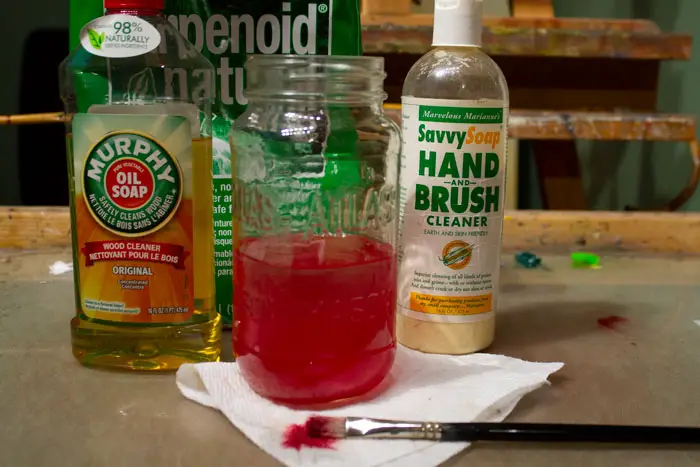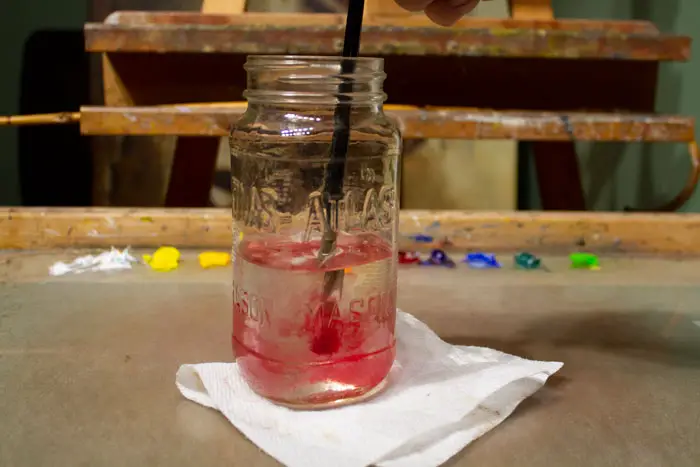
How to Clean Oil Painting Brushes During and After Painting
Good oil painting brushes are not cheap. Yet if they're properly cared for, they can last you for many paintings. Letting your brushes get stiff with dried oil paint will ruin your investment and your ability to paint. Let's look at some methods for how to clean your oil painting brushes during and after your painting sessions and how often you should clean them.
The best way to clean your oil painting brushes while painting is by using a solvent such as odorless mineral spirits or linseed oil (use proper disposal methods with linseed oil). When you are done painting brushes can be cleaned with Savvy Soap, Master's Brush Cleaner, or even Murphy's Oil Soap.
There are numerous methods and things to consider when it comes to cleaning oil brushes. Let's look at some of these methods in more detail.
Cleaning Brushes While Painting Using Solvents

The process for cleaning your brushes while painting is different than when you give them a final cleaning once you complete a painting. The process for cleaning brushes while painting should be simple yet adequate so as to keep your colors clean and not cause any disruption to the painting process.
One of the most common ways to clean oil painting brushes while painting is to dip them into a jar containing some type of solvent, such as odorless mineral spirits. The benefit of this approach is that mineral spirits are really good at removing a significant amount of paint in the quickest amount of time. A few dabs at the bottom of the jar will get most of any color out of the bristles.
The drawback to using a solvent is the fumes. Solvents evaporate quickly and are very easy to breathe in. If you are painting in an enclosed studio, there are health concerns from breathing in all those fumes. Be sure to use adequate ventilation when using solvents indoors, which is changing the air in your studio at least 10 times per hour.
Non-artist grade mineral spirits, such as those found at the hardware store will usually have an odor, even though they claim to be odorless. Artist-grade mineral spirits such as Gamblin's Gamsol are much more odorless. Yet even though they may not smell, the fumes are still there. But the great thing about Gamsol is that its evaporation rate is slower than other solvents and it doesn't usually absorb through the skin.
Another mineral spirit commonly used by artists is Turpenoid made by Weber. While this is a good artist-grade mineral spirit, I've found it to have a stronger small than Gamsol.
There are other solvents such as turpentine or alcohol. These should be avoided. Most modern turpentines contain very strong odors and fumes, and alcohols will dry out your brushes and damage them.
Cleaning Brushes While Painting Using Oils

If you want to avoid using solvents in your studio you can use oils such as linseed oil to clean your brushes. The most obvious benefit is that oils do not give off the odors and potentially harmful fumes that solvents do. Depending on how sensitive your sniffer is, you may not smell the oil at all. Since it doesn't evaporate like solvents, an open jar will last much longer. In fact, you don't need to close the jar at all.
While oils do a pretty good job of cleaning your brushes, the results are not as quick an immediate as solvents. You will have to spend a little more time swishing or rubbing your brush around the jar to remove the pigment. And it can seem a bit more messy until you get used to it.
Another drawback with using linseed oil is that you can end up with a buildup of hardened linseed oil around the jar. This hardened oil can be cleaned with a razor blade but it's a bit of a chore.
The most important thing to be aware of is the proper disposal of any paper towels or rags that you use to wipe the excess oil. Rags or paper towels that are soaked in oils such as linseed oil can spontaneously combust. Therefore you must dispose of them in a metal or fireproof trash can that has a proper lid. I can personally say that I've been using this exact method of cleaning my brushes for over 10 years and have never had combustion occur. But I don't take any chances and neither should you.
Other Cleaning Options While Painting
If fumes or metal garbage cans are not your style, there are other options to try. Turpenoid Natural, also made by Weber is a non-toxic, flammable, citrus-based brush cleaner that works really well for cleaning while painting. It has a thicker consistency like linseed oil, and a strong citrus odor which some people may not like, but is free of any harmful fumes. You also don't need to worry about spontaneous combustion.
Turpenoid Natural is also incredible for cleaning brushes that have become stiff from neglect of cleaning. There have been a number of times when I forgot to clean a brush that become stiff and hard. But soaking the bristles in Turpenoid Natural overnight will usually loosen up the bristles and render the brush useable again. I can't say it makes the brush like new, but it does save it from the garbage can.
It should be noted that unlike artist-grade mineral spirits or linseed oil, Turpenoid Natural should not be used as a medium for thinning oil paints.
Other similar options are Chelsea's Classical Studio Citrus or Lavendar Brush Cleaners. Once again these do not contain harmful fumes. Some artists like the odor of these items, others don't.
There is also Windsor Newton Brush Cleaner and Restorer. Once again it's non-toxic and has less odor than other cleaners. It's also really good at restoring hard bristles.
What to Clean Your Brushes In
So now you have some options on what to use to clean your brushes, but what exactly should you clean them in? Of course, the cheapest solution would be a thoroughly cleaned soup can or jar. If you are using solvents you will want a jar with a lid to keep down on evaporation and fumes.
Another option is the Silicoil Brush Cleaner Tank. This is a handy jar with a lid that contains a large coil to rub your brushes against to get a more thorough cleaning. Since I use linseed oil to clean my brushes while painting, my jar ended up getting pretty gunky over time and had to be disposed of. Yet I kept the coil and use it in a food jar and it still works great!
Whatever you use, make sure that you clean it periodically. Oil paint will build up at the bottom of the container and will make it more difficult to clean your brushes. Since I use linseed oil cleaning my container is a bit messier and I honestly don't do it as often as I should. When you clean your container make sure you wear gloves, especially if you clean your brushes with linseed oil. The pigment buildup in the bottom of the jar can contain toxic substances such as Cadmium and Cobalt and can be difficult to clean off your skin.
Cleaning Your Brushes After Painting
There is a difference in how you clean your brushes while your painting versus how you give them a final cleaning after you are done painting. Cleaning while painting is just to remove most of the color currently on the brush so you can use that same brush for another color and not create a mess on your canvas. Cleaning your brushes when you are done painting is meant to remove all the pigment, oil, and medium in the bristles so the brush doesn't become stiff and unusable. There are many ways of doing this, but I'll discuss some of the methods I've used and my current method.
Final Cleaning with Solvents
Just as with cleaning while painting, you can use solvents to give your brushes a final cleaning. You will want to use a generous amount of solvent as the paint will pollute the solvent very quickly. It's best to use two jars of solvent, one to get the bulk of the paint off, and another to give a final clean rinse.
Final Cleaning with Oils
Doing a final cleaning with oils alone is not recommended. The oils will harden the bristles after a week or so. Using oils to clean while painting is fine, but not for a final cleaning.
Final Cleaning with Turpenoid Natural
Turpenoid Natural can be used for a final cleaning, but it should be backed up with either a rinse with solvents or soap and water as it can gum up the bristles when it dries.
Final Cleaning with Soap and Water
They say oil and water do not mix, so one may be tempted to think that this method doesn't work but it actually works really well. Basically, you put soap in your hands and rub the bristles of the brush in your palm to lather up the soap, then rinse and repeat until the lather is clean. The result is a nice, clean brush that doesn't harden over time.
When using this method you will want to wear latex gloves to keep any toxic pigment off of your hands. It's also a good idea to try to clean most of the paint off your brushes using some other method such as solvents or oil in a jar. This will cut down on the amount of paint and toxins you are putting into the sewer or septic system.
There are different soaps you can use to clean your brushes. The Master's Brush Cleaner and Preserver is a good one that I've used with great results. Another is Chelsea Lavender & Olive Oil All Natural Brush Cleaner & Conditioning Soap.
This used to be my primary method for cleaning my brushes but I stopped many years ago as I was concerned about introducing heavy metals such as cadmium and cobalt into the local water supply. If you do use this method and want to keep the water supply as clean as possible, be sure to remove as much paint as possible before you wash your brushes in the sink.
Final Cleaning with Savvy Soap

Savvy Soap made by Marvelous Marianne's Products is another great brush cleaner. It's non-toxic and like Turpenoid Natural can revive hardened bristles. It has a yogurt-type consistency. You can squeeze some onto a clean surface, rub your bristles into it, then wipe with a paper towel and repeat until clean.
I love using this when on painting trips where I cannot use my usual method of cleaning brushes (see below). It's portable and can even be used to clean paint from your hands.
My Final Cleaning Method
My method of cleaning oil painting brushes is one of the most economical and efficient methods I've come across over my years of oil painting. I use Murphy's Oil Soap and cheap mineral spirits.
I will first remove any excess paint with the linseed oil I clean with while I'm painting, I then wipe the brush with a paper towel. I may repeat this process a couple of times depending on how much excess paint I have on my brushes.

I then pour some Murphy's Oil Soap onto my glass painting palette (be sure the palette is absolutely clean of all paint prior to doing this, I use denatured alcohol to clean my palette). Then I will dip the bristles into the pool of oil soap and press down onto the glass and move the brush back and forth. When you do this you will see a lot of paint coming out of the bristles. I then wipe the excess oil soap and paint with a paper towel. I may repeat this process a couple of times, depending on how much paint was in the brush.

Even though your pool of oil soap will quickly pollute with paint, you can continue to use it to clean your other brushes as the oil soap will continue to extract paint even when it's polluted. All within reason of course. If the oil soap becomes completely polluted, you may need to replace it with a clean pool of oil soap.

Oil soap will not remove every bit of paint from your brush. I accomplish this by then dipping the brush into a large jar of mineral spirits. While you can use Gamsol, the cheaper (and stinkier) mineral spirits from the hardware store work just fine. Wipe off the excess mineral spirits with a paper towel and repeat until the paper towel wipes clean. Your brush should now be good for storing.
Over time you will notice oil paint separating and settling at the bottom of the mineral spirits jar. This is fine to continue to use. Some people may poke holes in the bottom of a tuna can (or similar) and place it bottom-up in the jar to further separate the oil from the clean mineral spirits. At some point, you will need to replace the mineral spirits but they will stay clean for quite a while.
How Often You Should Clean Your Brushes
The question that may come to mind is how often should you clean your brushes?
There is no hard and fast rule and there are many variables that could determine how often you should give your brushes a final cleaning. The safest practice is to do a final cleaning every day when your painting session is complete. Just bear in mind that cleaning your brushes every day will deplete your cleaning solution must faster, and it may not be necessary.
If you paint every day and clean your brushes with some type of oil while painting, and you don't use a lot of drying mediums, you may only need to give your brushes a final cleaning every few days or even once a week.
I typically clean my brushes about once or twice a week, usually on Saturdays since I don't paint on Sundays. I do make sure to wipe any excess paint from my brushes and give them a quick rinse in linseed oil at the end of the day. I'm not officially recommending this somewhat lax approach since I'm a bit lazy when it comes to cleaning, I'm just telling you what I honestly do. The best practice is to clean every day at the end of the day, or at least every couple of days.
Jason Tako is a nationally known fine artist who specializes in western, wildlife, plein air, and Historical Native American subject matter. He spent his learning years sketching the wetlands and wooded areas of rural Minnesota. He has been featured in Plein Air Magazine and Western Art Collector Magazine and he was the Featured Artist for the 2020 Southeastern Wildlife Expo. See his work at www.JasonTako.com and his demonstrations on his YouTube Channel.
Warning: Undefined array key "preview" in /home3/mysketc2/public_html/wp-content/plugins/oxygen/component-framework/components/classes/comment-form.class.php on line 75

Warning: Undefined array key "preview" in /home3/mysketc2/public_html/wp-content/plugins/oxygen/component-framework/components/classes/comment-form.class.php on line 79